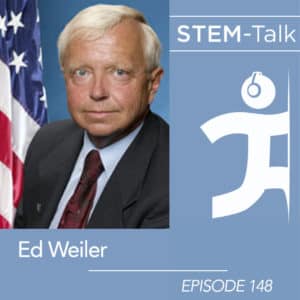STEM-Talk: Ed Weiler on the Hubble and James Webb telescopes and NASA’s search for life
Published 1.31.23
Ed Weiler wanted to be among NASA’s first scientist astronaut. He made it through several rounds of selection, but in the end, he wasn’t chosen.
“Then I gave up and was happy to be an astronomer,” Weiler says.

Fortunately, he had another path that brought him to NASA. Indeed, he went on to a 33-year career at the National Aeronautics and Space Administration, including 20 years as chief scientist for the Hubble Space Telescope, the forerunner of the James Webb.
In STEM-Talk Episode 147, available now on IHMC’s website and wherever you listen to podcasts, Dr. Ed Weiler talks about his career, one in which he wore many hats. His roles included Associate Administrator of the Science Mission Directorate; Center Director of NASA’s Goddard Space Flight Center, Associate Administrator for NASA’s Space Science Enterprise, chief of the Ultraviolet/Visible and Gravitational Astrophysics Division and director of the Astronomical Search for Origins Program.
The conversation in this episode includes:
— NASA’s accomplishments in the past year, including the Perseverance mission, the success of the James Webb telescope, and the launch of Artemis-1.
— Ed’s experience as the Chief Scientist for the Hubble Space Telescope during its early development.
— Ed’s time as the director of NASA’s Astronomical Search for Origins program.
— Ed’s role in the development of the New Horizons spacecraft and its mission to fly by and study Pluto and its moons.
— Ed’s belief that in the next 20 to 50 years, we will be able to prove the existence of other life in the universe. “Within 15 or 20 years… our grandchildren will live to be able to observe for the first time in history humans being able to say, ‘We are not alone.’”
Latest News
- David Bear joins IHMC Board of Directors
- STEM-Talk: Michael Schmidt on building a space-faring civilization
- Florida Blue award supports health and wellness research and outreach at IHMC
- STEM-Talk: Ken Forbus on AI and his development of the Structure Mapping Engine
- STEM-Talk: Pascal Lee on returning to the Moon — and heading to Mars
- Aging Symposium draws experts to IHMC
- IHMC hosts Fredric G. Levin Lung Care Symposium March 27-28 in Pensacola
- Humanoid robotics and exoskeletons lead latest IHMC newsletter
- Celebrate Robotics Week at IHMC Open House on April 11, 2025

